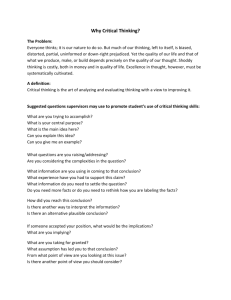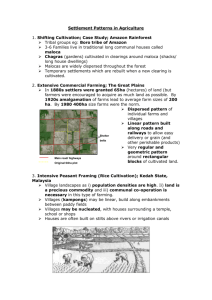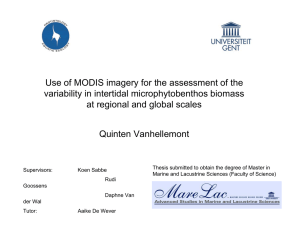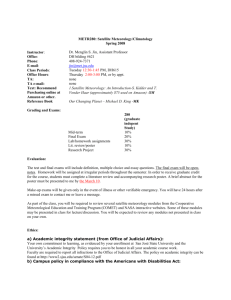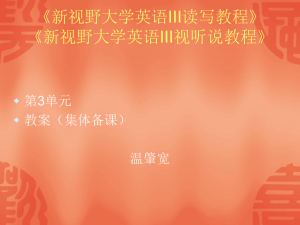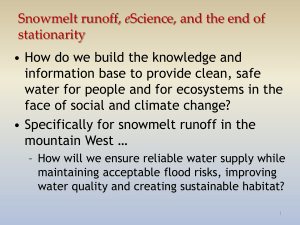CULTIVATED LAND CHANGE ANALYSIS OF YANGTZE RIVER DELTA REGION
advertisement
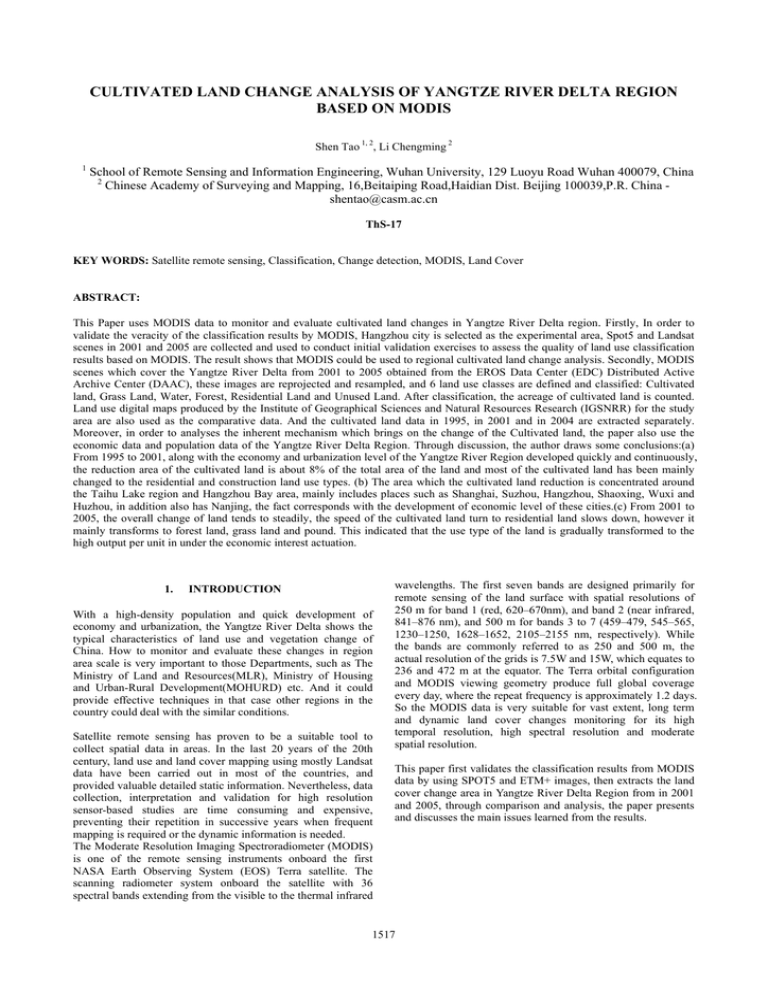
CULTIVATED LAND CHANGE ANALYSIS OF YANGTZE RIVER DELTA REGION BASED ON MODIS Shen Tao 1, 2, Li Chengming 2 1 School of Remote Sensing and Information Engineering, Wuhan University, 129 Luoyu Road Wuhan 400079, China 2 Chinese Academy of Surveying and Mapping, 16,Beitaiping Road,Haidian Dist. Beijing 100039,P.R. China shentao@casm.ac.cn ThS-17 KEY WORDS: Satellite remote sensing, Classification, Change detection, MODIS, Land Cover ABSTRACT: This Paper uses MODIS data to monitor and evaluate cultivated land changes in Yangtze River Delta region. Firstly, In order to validate the veracity of the classification results by MODIS, Hangzhou city is selected as the experimental area, Spot5 and Landsat scenes in 2001 and 2005 are collected and used to conduct initial validation exercises to assess the quality of land use classification results based on MODIS. The result shows that MODIS could be used to regional cultivated land change analysis. Secondly, MODIS scenes which cover the Yangtze River Delta from 2001 to 2005 obtained from the EROS Data Center (EDC) Distributed Active Archive Center (DAAC), these images are reprojected and resampled, and 6 land use classes are defined and classified: Cultivated land, Grass Land, Water, Forest, Residential Land and Unused Land. After classification, the acreage of cultivated land is counted. Land use digital maps produced by the Institute of Geographical Sciences and Natural Resources Research (IGSNRR) for the study area are also used as the comparative data. And the cultivated land data in 1995, in 2001 and in 2004 are extracted separately. Moreover, in order to analyses the inherent mechanism which brings on the change of the Cultivated land, the paper also use the economic data and population data of the Yangtze River Delta Region. Through discussion, the author draws some conclusions:(a) From 1995 to 2001, along with the economy and urbanization level of the Yangtze River Region developed quickly and continuously, the reduction area of the cultivated land is about 8% of the total area of the land and most of the cultivated land has been mainly changed to the residential and construction land use types. (b) The area which the cultivated land reduction is concentrated around the Taihu Lake region and Hangzhou Bay area, mainly includes places such as Shanghai, Suzhou, Hangzhou, Shaoxing, Wuxi and Huzhou, in addition also has Nanjing, the fact corresponds with the development of economic level of these cities.(c) From 2001 to 2005, the overall change of land tends to steadily, the speed of the cultivated land turn to residential land slows down, however it mainly transforms to forest land, grass land and pound. This indicated that the use type of the land is gradually transformed to the high output per unit in under the economic interest actuation. 1. INTRODUCTION With a high-density population and quick development of economy and urbanization, the Yangtze River Delta shows the typical characteristics of land use and vegetation change of China. How to monitor and evaluate these changes in region area scale is very important to those Departments, such as The Ministry of Land and Resources(MLR), Ministry of Housing and Urban-Rural Development(MOHURD) etc. And it could provide effective techniques in that case other regions in the country could deal with the similar conditions. Satellite remote sensing has proven to be a suitable tool to collect spatial data in areas. In the last 20 years of the 20th century, land use and land cover mapping using mostly Landsat data have been carried out in most of the countries, and provided valuable detailed static information. Nevertheless, data collection, interpretation and validation for high resolution sensor-based studies are time consuming and expensive, preventing their repetition in successive years when frequent mapping is required or the dynamic information is needed. The Moderate Resolution Imaging Spectroradiometer (MODIS) is one of the remote sensing instruments onboard the first NASA Earth Observing System (EOS) Terra satellite. The scanning radiometer system onboard the satellite with 36 spectral bands extending from the visible to the thermal infrared wavelengths. The first seven bands are designed primarily for remote sensing of the land surface with spatial resolutions of 250 m for band 1 (red, 620–670nm), and band 2 (near infrared, 841–876 nm), and 500 m for bands 3 to 7 (459–479, 545–565, 1230–1250, 1628–1652, 2105–2155 nm, respectively). While the bands are commonly referred to as 250 and 500 m, the actual resolution of the grids is 7.5W and 15W, which equates to 236 and 472 m at the equator. The Terra orbital configuration and MODIS viewing geometry produce full global coverage every day, where the repeat frequency is approximately 1.2 days. So the MODIS data is very suitable for vast extent, long term and dynamic land cover changes monitoring for its high temporal resolution, high spectral resolution and moderate spatial resolution. This paper first validates the classification results from MODIS data by using SPOT5 and ETM+ images, then extracts the land cover change area in Yangtze River Delta Region from in 2001 and 2005, through comparison and analysis, the paper presents and discusses the main issues learned from the results. 1517 The International Archives of the Photogrammetry, Remote Sensing and Spatial Information Sciences. Vol. XXXVII. Part B7. Beijing 2008 2. METHODS 2.1 Study area and Data sources The study comprises an area about 80,000 square kilometer of Yangtze River Delta, the triangular-shaped territory covers Shanghai, southern Jiangsu province and northern Zhejiang province of China. Because the south-east area of Anhui province is connected with these regions and the climate, terrain and vegetation in this area are all similar with the Yangtze River Delta Region, so the study area in this paper also comprises part of the Anhui province. High spatial resolution image classification scheme Middle spatial resolution image classification scheme Cultivated land Cultivated land Woodland Garden plot Lawn Forest Land Grass Land City Town Countryside inhabitant Residential and Construction Land Industrial Transportation Water Water Unused Unused Other Table 1. List of two classification schemes Figure 1. The study area and surroundings In this study, we use MODIS images as the main research data sources, these images cover the whole study area, corresponding to the same period during the period between August 2001 and 2005. The Landsat ETM+ images and Spot5 images are used as the validation data, such images only cover the Hangzhou city. In order to study the cultivated land changes in past 10 years of Yangtze River Delta, Land use digital maps produced by the Institute of Geographical Sciences and Natural Resources Research (IGSNRR) for the study area are also used as the comparative data. These digital maps were digitized at 1:250,000 scale from Landsat TM in 1995. For deep dive analysis of the change tendency, the population and economic statistical data are also used 2.2 Data preprocess All the images should be preprocessed before they could be used. The methods to deal with these images have sufficient discussion in related references; this paper does not make further research. The process mainly includes data-extracting, spatial correction, projection variation, geometry registration, enhancement and data fusion, etc. The study used ENVI remote sensing software to process these images and obtained sound effects. In order to improve regional land cover classification accuracy, the classification characters selection and extraction also should consider land use characteristic of the Yangtze River Delta region. And acquisition of geographic background studying and professional knowledge helps to valid classification character selection. For MODIS data, other characters such as vegetation index, water and humidity, texture and temperature can also increase classification accuracy. Maximum Likelihood Classifier is adopted in this paper, and the training data are extracted from the Land Use Digital Map, because the map is validated by the ground truth data, so we can consider that the data of the map is reliable and has the enough precision to meet the demands of the classification of the remote sensing images. Through the classification, the land use class data covering the study area are extracted from MODIS images in 2001 and 2005, and the validation area classification results are also obtained from ETM+ images in 2001 and SPOT5 images in 2005. Then the post-classification comparison method is introduced, the dynamic cultivated land change can be collected easily. The Figure2 shows the land use classification results of MODIS data in 2001 and 2005. 2.3 Classification This paper aims to analyze the change of the cultivated land, so the image classification references the land use classification scheme. And the study used two classification schemes based on the different spatial resolution of SPOT5, ETM+ and MODIS images. When two classified data sets are compared each other, some elaborated classes will be combined for identification, the table 1 shows two classification schemes and the corresponding class between two schemes. 1518 (a) Land Use in 2001 (b)Land use in 2005 Figure 2. Classification results of study area The International Archives of the Photogrammetry, Remote Sensing and Spatial Information Sciences. Vol. XXXVII. Part B7. Beijing 2008 (MODIS and ETM+ data in 2001) 2.4 Validation In order to validate the veracity of the classification results by MODIS, several experiments are taken, and Hangzhou is selected as the experimental area, twenty-four Spot5 scenes and six Landsat scenes in 2001 and 2005 are collected, these images are used to conduct initial validation exercises to assess the quality of land use classification results based on MODIS. The Land use dataset which covers experimental area is classified and extracted from Landsat ETM+ images in 2001, while the much large scale land use dataset which covers the same area is produced from Spot5 images in 2005. Because the overall accuracy of the ETM+ and Spot5 is reliable, so we just combine the classes and transform the result to the same classification scheme, and rasterize the land use vector datasets of different scales to the same resolution, finally compare it with the MODIS classification results. CL FL CL 176 25 WL 23 181 GL 8 13 RL 2 2 WA 5 3 UL 3 3 Overall accuracy = 0.788 GL RL WA UL 23 1 3 5 19 1 5 2 76 1 2 3 3 95 2 1 7 3 122 8 4 2 7 51 Kappa co coefficient = 0.737 Table 3. Classification validation results (MODIS and SPOT5 data in 2005) The validation results come out that the accuracy of classification is reliable, and the MODIS image could be used to regional cultivated land change analysis. 3. RESULTS AND DISCUSSION (a) (b) (d) (e) When the results of the MODIS image classification are produced, cultivated land as the single class of the classification result, it could be extracted from the data separately, the values are 43,000 square kilometers in 2001 and 42,000 square kilometers in 2005. we also counted the cultivated land area from the 1:250,000 Land Use Digital Map in 1995 and the value of 49,000 square kilometers is obtained. Comparisons are made among three time points of 1995, 2001 and 2004. Figure4 shows the comparison result, (a) shows the change parts compared by 2001 and 1995, the areas in red and yellow color are reduction parts and the areas in green color are addition parts. (b) shows the change areas compared by 2005 and 2001. The detailed change values are shown in the Table 4. (c) (f) Figure 3. The classification data for validation (a) shows the classification result extracted from the ETM+ image in 2001, (b) shows the rasterization result of classificaiton data (a), while (c) shows the classification result extracted from the MODIS image in 2001, (d) shows the classification result extracted from the SPOT5 image in 2005, (e) shows the rasterization result of classificaiton data (d), and (f) shows the classification result extracted from the MODIS image in 2005. For the sake of validation of the classification result, sample points are selected from (b) and (c) in the corresponding place, the same to (e) and (f). We can calculate the classification overall accuracies through sample points, and obtain the results are 81% and 79%. The detailed results are shown in the table together with the accuracies for single classes. CL FL CL 189 31 WL 21 167 GL 11 7 RL 2 3 WA 6 4 UL 3 1 Overall accuracy = 0.813 GL RL WA UL 16 1 4 1 19 1 3 2 79 1 2 3 1 102 1 1 5 0 132 8 2 2 3 49 Kappa co coefficient = 0.768 Table 2. Classification validation results (a) (b) Figure 4. Comparison of the cultivated land change of two periods 1995~2001 Change Area k㎡ 2001~2005 Increase Reduce Change rate 355 6742 -7.6% Change Area k㎡ Increase Reduce Change rate 206 1295 -1.2% Table 4. Detailed change values of two periods During the period from 1995 to 2001, along with the huge development of economy and continuous enhancement of urbanized level, the cultivated area has changed greatly. And about 7.6% of the total area has changed, it could be increased by transform from other land use types, but most of the change is that the cultivated land transformed to other land use types. 1519 The International Archives of the Photogrammetry, Remote Sensing and Spatial Information Sciences. Vol. XXXVII. Part B7. Beijing 2008 The reduction of cultivated land is obvious, reaches to 8.3%. Through the analysis, we can find that cultivated land is mainly transformed to residential and construction land in this period. The area which the cultivated land reduces is concentrated around the Circum-Taihu Lake region and Hangzhou bay area, from 1995 to 2001, mainly included places such as Shanghai, Suzhou, Hangzhou, Shaoxing, Huzhou, Wuxi and Yangzhou, in addition also has Nanjing, this also corresponds with local economy levels of these areas.. During the period from 2001 to 2005, the overall change of land tends to steadily, the speed of the cultivated land turn to residential land slows down, the transform mode of land use type also changed, the tendency from cultivated land to residential and construction land turns to mainly transform to forest land, lawn and pit pond. This indicated that along with the development of the market economy, the cultivated land is much likely to transform to the land type with high economical output per unit, under the economic interest actuation. In addition, there has also existed the mixed pixels and other causations in image classification process, the cultivated land is easy to confuse with surrounding land types such as forest, lawn etc, it brings difficulty for land information extraction. Therefore the results also exist some unreasonable land type transformation. But whole results are reliable. Moreover, in order to analyses the inherent mechanism which brings on the change of the Cultivated land, we also use the economic data and population data of the city of the Yangtze River Delta. The paper presents the reasons from nature and social driving forces. The industrialization and urbanization are the direct forces for cultivated land change. Since the 20th 90's,the development of economy of the Yangtze River Delta Region has kept high speed, so with the enhancement of the industrialization and urbanization level, residential and construction land use types has unceasingly increased, also inevitably caused the vast agriculture land to transform into the non- agriculture land. This paper uses the GDP statistics in 1995 and 2005 from the cities in study area, the change values are obtained and expressed in the thematic map, Comparing with the cultivated land change map during the same period, the study discovered that the result is consistent. The population is the primary factor which causes the changes of the land. This paper analyzed and compared the population in 1995 and 2005 of study area, and expressed it in the thematic map, and find the result is also consistent with the cultivated land change tendency. We also noticed that some cities in the study area appeared the negative growth of the population because of the development of economy and adjustment of the population structure. So conclusion can be made that if the area has high modernization, its population may strengthen the correlations with other land utilization type. Physical geography condition also affects the land use change. The influence of the physical geography condition to cultivated land change mainly relies on the geographical position. Where there has the convenient transportation, smooth topography as well as the land around the city is much easier to transform to residential and construction land. In addition, land use change also related with topographical condition. The forest land with higher elevation and harder reach condition are less influenced by human activities, and the land change mainly caused by natural condition. 4. CONCLUSION The study proposed and implemented a suite of techniques and methods for extracting the change information of cultivated land from the total land use data of Yangtze River Delta Region. The results show that cultivated land area has changed greatly in the past ten years; and the land use transformation type of the study area also altered since 2001, in the first five years, the cultivated land mainly transformed to residential and construction land, but it transformed to land type with high economical output per unit in the last five years. Nevertheless the results and the change values have some limitations when it is used at the local level because of the coarse spatial resolution and classification scheme, the lack of local training is also the sources of inconsistencies, but this study provides a better understanding of the behavior of MODIS data sets in cultivated land change detection at the regional level. As cultivated land information is becoming increasingly important to develop environmentally sustainable strategies and policies, moderate resolution imagery are meant to become more useful and significant. These flexible approaches are especially suitable for developing areas in China where the vibrant economic activities require rapidly updated land use information. The MODIS solutions rely on basic and commonly used techniques and field data collected for land use and land cover projects is available for most of the areas in the country. 5. ACKNOWLEDGMENTS Slowly (a) GDP Quickly (b) Population This work was funded by the Special Social Commonweal Research Programs of ‘Research of the monitoring and evaluation techniques to the environment and cultivated land of Yangtze River Delta’ by the Ministry of Science and Technology P. R. China. The authors also thank the Institute of Geographical Sciences and Natural Resources Research (IGSNRR) for providing the Land Use Digital Map of the study region. Figure 5. The increase speed of GDP and Population in the study area in the period of 1995 and 2005 1520 The International Archives of the Photogrammetry, Remote Sensing and Spatial Information Sciences. Vol. XXXVII. Part B7. Beijing 2008 REFERENCES Sedano, F., Gong, P., &Ferrao, M., 2005. Land cover assessment with MODIS imagery in southern African Miombo ecosystems. Remote Sensing of Environment, 98(4), pp. 429– 441. Latifovic, R., Zhu, Z. L., Cihlar, J., Giri, C., & Olthof., 2004. Land cover mapping of North and Central America-Global Land Cover 2000. Remote Sensing of Environment, 89(1), pp. 116–127. Prasad, S. Thenkabail, T., Mitchell, Schull., & Hugh, Turral., 2005. Ganges and Indus river basin land use/land cover (LULC) and irrigated area mapping using continuous streams of MODIS data. Remote Sensing of Environment, 95(3), pp. 317–341. Townshend, J.R.G., & Justice, C.O., 2002. Towards operational monitoring of terrestrial systems by moderate-resolution remote sensing. Remote Sensing of Environment, 83(1), pp. 351–359 Jeremy, I., Fisher., & John, F. Mustard., 2007. Cross-scalar satellite phenology from ground, Landsat, and MODIS data. Remote Sensing of Environment, 109(3), pp. 261-273. Chang, G. P., Ding, Y. G., & Yu, H. B., 2003. Land-use Dynamic Change in the Yangtze Delta Based on RS and GIS Technology. Journal of Nanjing Institute of Meteorology, 26(3), pp. 815-820. Giri, C., Zhu, Z. L., & Reed, B. 2005. A comparative analysis of the Global Land Cover 2000 and MODIS. Remote Sensing of Environment, 94(1), pp. 123-132. Jönsson, P., & Eklundh, L., 2002. Seasonality extraction by function fitting to time-series of satellite sensor data. IEEE Transactions on Geoscience and Remote Sensing, 40, pp. 1824−1832. Foody, G. M., 2002. Status of land cover classification accuracy assessment. Remote Sensing of Environment, 80, pp.185–201. 1521 The International Archives of the Photogrammetry, Remote Sensing and Spatial Information Sciences. Vol. XXXVII. Part B7. Beijing 2008 1522
